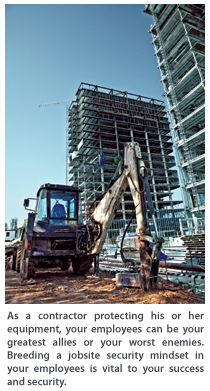Smart Equipment Defense
 Regardless of who owns the equipment, when it’s on your jobsite, you want to keep it there and keep it working. The first line of defense is also the simplest — fence in your equipment. Sure, that can mean a standard chain link fence, or simply make one out of machines. That’s right: You can make a barrier of metal by parking your equipment close together and in a circle if possible.
Regardless of who owns the equipment, when it’s on your jobsite, you want to keep it there and keep it working. The first line of defense is also the simplest — fence in your equipment. Sure, that can mean a standard chain link fence, or simply make one out of machines. That’s right: You can make a barrier of metal by parking your equipment close together and in a circle if possible.
Position machines near the front of the jobsite, next to a busy road and near lights if possible. Make the equipment as visible as you can and inform your local police agency of typical jobsite hours so if they observe activity after hours they will know to investigate. Also use devices such as wheel locks, fuel shut-offs, ignition locks and battery-disconnect switches. Unfortunately, seasoned criminal vets can work around these precautions.
That’s why you need a second line of defense — a combination of thorough machine records and a tracking system. You should label all equipment with unique identifying numbers, including vehicle identification numbers (VIN) and owner applied numbers (OAN). Your inventory records should be spot on. Record manufacturer, model number, year, VIN and purchase date for each piece of equipment. You can take this concept one step further by registering the machine on the National Equipment Register (www.nerusa.com) database and adding an NER decal to deter thieves.
The latest development in crime-fighting technology is equipment-tracking hardware and software. Based either in cell phone signal, radio frequency or GPS technology, these systems offer an additional layer of protection when compared to your typical telematics system. By installing a tracking system, you can easily locate your equipment and set alerts for if your machine leaves pre-determined parameters, among other features.

Comments are closed here.